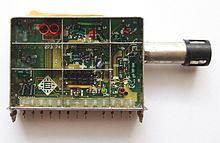| Revision as of 11:43, 29 October 2011 editEmausBot (talk | contribs)Bots, Template editors2,861,217 editsm r2.6.4) (Robot: Modifying ar:توليف (راديو)← Previous edit | Revision as of 23:28, 30 October 2011 edit undoRua (talk | contribs)Extended confirmed users7,765 edits →AM/FMNext edit → | ||
| Line 21: | Line 21: | ||
| Most of the top end audio tuner models were designed and manufactured to receive only the FM broadcast band. As FM became more popular, the limitations of AM became more apparent, and FM became the primary listening focus, especially for stereo and music broadcasting. The bulk of tuners made for the market, however, were AM/FM design, especially in the 1980s and 1990s. Few companies even manufacture dedicated FM or AM/FM tuners now, as these bands are most often included in a low cost chip for A/V systems, more as an afterthought, rather than designed for the critical FM listener. The FM aficionado must really look to the classic tuner models and either rebuild or upgrade the unit to satisfy demanding FM listeners. A few 1970s tuners feature now-deprecated ] for FM broadcasts. | Most of the top end audio tuner models were designed and manufactured to receive only the FM broadcast band. As FM became more popular, the limitations of AM became more apparent, and FM became the primary listening focus, especially for stereo and music broadcasting. The bulk of tuners made for the market, however, were AM/FM design, especially in the 1980s and 1990s. Few companies even manufacture dedicated FM or AM/FM tuners now, as these bands are most often included in a low cost chip for A/V systems, more as an afterthought, rather than designed for the critical FM listener. The FM aficionado must really look to the classic tuner models and either rebuild or upgrade the unit to satisfy demanding FM listeners. A few 1970s tuners feature now-deprecated ] for FM broadcasts. | ||
| In Europe, where a second AM broadcast band is used for ], tuners may be fitted with both the standard medium wave and the additional longwave band. However, radios with only medium wave are also common, especially in countries where there are no longwave broadcasters. Rarely, radios are sold with only FM and longwave, but no medium wave band. | |||
| ==Television== | ==Television== | ||
Revision as of 23:28, 30 October 2011

A radio tuner is a subsystem that receives radio broadcasts and converts them into audio-frequency signals which can be fed into an amplifier driving a loudspeaker. FM tuner, AM tuner, Digital Audio Broadcasting DAB tuner, etc. are types of radio tuner dealing with transmissions using different methods of modulation. The term tuner can mean either part of a radio receiver or standalone audio components that are part of an audio system, to be connected to a separate amplifier. The verb tuning in radio contexts means adjusting the radio receiver to receive the desired radio signal from a particular radio station.
Design

The simplest tuner consists of an inductor and capacitor connected in parallel, where the capacitor or inductor is made to be variable. This creates a resonant circuit which responds to an alternating current of one frequency. Combined with a detector, also known as a demodulator, (diode D-1, in the circuit), it becomes the simplest radio receiver, often called a crystal set.
Practical radio tuners use a superheterodyne receiver. Older models would realize manual tuning by means of mechanically operated ganged variable capacitors. Often several sections would be provided on a tuning capacitor, to tune several stages of the receiver in tandem, or to allow switching between different freqeuncy bands. A later method used a potentiometer supplying a variable voltage to varactor diodes in the local oscillator and tank circuits of front end tuner, for electronic tuning. Still later, phase locked loop methods were used, with microprocessor control.
In a self-contained radio receiver, the signal from the detector after the tuner is run through a volume control and to an amplifier stage. The amplifier feeds either an internal speaker or headphones. In a tuner component of an audio system (for example, a home high-fidelity system or a public address system in a building), the output of the detector is connected to a separate external system of amplifiers and speakers.
The broadcast FM band (88 to 108MHz in most countries) is around one hundred times higher in frequency than the AM band and provides enough space for a bandwidth of 50kHz. This bandwidth is sufficient to transmit both stereo channels with almost the full bandwidth of the human ear. Sometimes, additional subcarriers are used for unrelated audio or data transmissions. The left and right audio signals must be combined into a single signal which is applied to the modulation input of the transmitter; this is done by the addition of an inaudible subcarrier signal to the FM broadcast signal. FM stereo allows left and right channels to be transmitted. The availability of FM stereo, a quieter VHF broadcast band, and better fidelity lead to the specialization of FM broadcasting in music, tending to leave AM broadcasting with spoken-word material.
Restoration
Standalone audio stereo FM tuners are sought after for audiophile and TV/FM DX applications, especially those produced in the 1970s and early 1980s, when performance and manufacturing standards were among the highest. In many instances the tuner may be modified to improve performance. A growing hobby trend is the electronics specialists that buy, collect and restore these vintage FM or AM/FM audio tuners. The restoration usually begins with replacing the electrolytics (capacitors) that age over time. The tuner is outfitted with improved tolerance and better sounding upgraded parts. Prices have increased relative to the increasing demand for the older audio tuners. Those with the most value are the best sounding, most rare (collectible), the best DX capable (Distance Reception) and the known build quality of the component, as it left the factory.
AM/FM
Most of the top end audio tuner models were designed and manufactured to receive only the FM broadcast band. As FM became more popular, the limitations of AM became more apparent, and FM became the primary listening focus, especially for stereo and music broadcasting. The bulk of tuners made for the market, however, were AM/FM design, especially in the 1980s and 1990s. Few companies even manufacture dedicated FM or AM/FM tuners now, as these bands are most often included in a low cost chip for A/V systems, more as an afterthought, rather than designed for the critical FM listener. The FM aficionado must really look to the classic tuner models and either rebuild or upgrade the unit to satisfy demanding FM listeners. A few 1970s tuners feature now-deprecated Dolby noise reduction for FM broadcasts.
In Europe, where a second AM broadcast band is used for longwave broadcasting, tuners may be fitted with both the standard medium wave and the additional longwave band. However, radios with only medium wave are also common, especially in countries where there are no longwave broadcasters. Rarely, radios are sold with only FM and longwave, but no medium wave band.
Television
A television tuner converts an radio frequency analog television or digital television transmission into audio and video signals which can be further processed to produce sound and a picture. Different tuners are used for different television standards such as PAL, NTSC, ATSC, SECAM, DVB-C, DVB-T, ISDB, T-DMB, open cable.
Analog tuners can tune only analog signals. An ATSC tuner is a digital tuner that tunes digital signals only and yet some digital tuners have an analog bypasses.
VHF/UHF TV tuners are rarely found as a separate component, instead are incorporated into television sets. Cable boxes are set top boxs that serve as a separate tuner, and have channel 3/4 outputs for TV sets that aren't cable-ready. They often feature composite, S-video, or component video outputs so they can be used on video monitors that do not have a TV tuner, or direct video inputs. They are usually bundled with a video monitor, VCR, and/or digital video recorder (DVR).
TV tuner card are also installed on PCI computer expansion cards (or in USB device, or even as a part of video card), together with a Digital signal processor (DSP), allowing a personal computer to display and/or capture television channels. A number of earlier models were stand-alone tuners, designed to deliver TV picture through a VGA connector. This allowed viewing television on a computer display, but, of course, did not allow recording television programs by the PC.
See also
- Analog passthrough
- ATSC tuner
- Cable converter
- Digital television adapter (DTA)
- QAM tuner
- Radio antenna
- Receiver (radio)
- Set top box
- Television antenna
- Television set
- TV tuner card
- Receiver (radio)
- Television set
- Tuner (television)